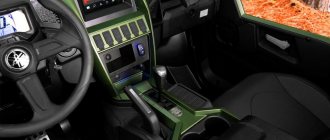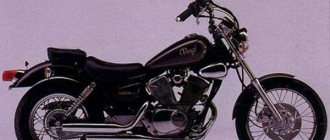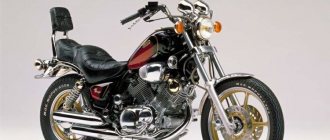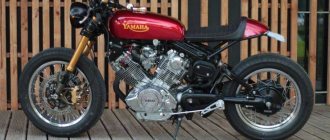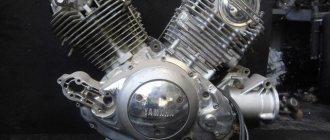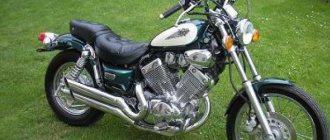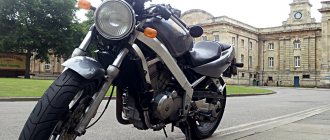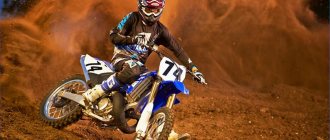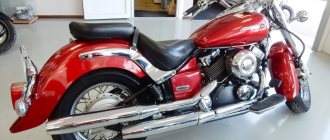| Yamaha Virago 535 (XV535) 1987-2003 |
Cruiser model Yamaha Virago 535
was first introduced in 1987 and is aimed at the markets of North America and Europe (mainly the UK).
The full name of the model is Yamaha XV535 Virago
. Based on this model, a domestic Japanese version of the Yamaha Virago 400 was also produced, which differed only in engine size.
The Yamaha XV535 Virago is a mid-size cruiser with a classic layout - spoked wheels, a 2-cylinder V-twin air-cooled engine and a cardan drive. At that time, Japanese motorcycle manufacturers did not have much experience in building cruisers, and therefore the models of those years were quite boosted and showed solid dynamic characteristics. For example, the Yamaha XV 535 Virago produced up to 46 hp. power, while the Yamaha Drag Star 650 that replaced it, which had a larger engine, produced only 40 hp. It is this main feature, coupled with a relatively low curb weight, that is characteristic of all Japanese short-wheelbase cruisers of that time.
Other features of the Yamaha Virago 535 include a steel frame with an engine as a supporting element, a 5-speed gearbox, 19′ and 15′ wheels, simple suspension in the form of a conventional telescopic fork in the front and a double shock absorber in the rear, a 13.5 liter fuel tank (before 1989 - 8.6 l) and 195 kg curb weight.
The Yamaha XV 535 Virago model was sold on the market until 2003, even though in 1997 the successor Yamaha XVS 650 Drag Star (V-Star 650 in the American market) appeared, which was supposed to replace the old Virago. Currently, the Yamaha Virago 535 model is not very popular in the Russian Federation due to the fact that official sales did not extend to Japan and nearby countries. Instead, the domestic Japanese model Virago 400 is present on the Russian market, which is popular at Japanese auctions and is one of the most affordable cruiser models in the Russian Federation.
The main competitors of the Yamaha Virago 535 in the class:
- Honda Steed 600
- Kawasaki Vulcan 500 LTD
- Suzuki VS600 Intruder
Brief history of the model
- 1987 - start of production and sales of the Yamaha XV535 Virago model.
Model
: Yamaha Virago 535 (USA).
Factory designation
: XV535T, XV535TC.
- 1988 - no significant changes.
Model
: Yamaha Virago 535 (Europe, USA).
Factory designation
: 2JV0, 2YL, 3BM1, 3BR1, 3BT1, XV535U.
- 1989 - the model receives an additional fuel tank (the main tank is under the seat), the total capacity increases to 13.5 liters. The seat is divided into 2 parts and provides for the removal of the passenger part with access to a small glove compartment.
Model
: Yamaha Virago 535 (Europe).
Factory designation
: 3BM2, 3BM3, 3BR2, 3BR3, 3BT3, 3BT5, 3BT6, 3JC3.
- 1990 - no significant changes.
Model
: Yamaha Virago 535 (Europe, USA).
Factory designation
: 3BM4, 3BT8, 3BT9, 3BTA, 3BTB, 3BTC, 3JC4, XV535A, XV535AC.
- 1991 - no significant changes.
Model
: Yamaha Virago 535 (Europe).
Factory designation
: 3BM5, 3BR5, 3BTD, 3BTF, 3BTG, 3BTH.
- 1992 - no significant changes.
Model
: Yamaha Virago 535 (Europe).
Factory designation
: 3BM6, 3BR6, 3BTJ, 3BTK, 3BTL, 3BTM, 3BTN.
- 1993 - aluminum decorative parts are replaced with chrome plated ones - this applies, first of all, to the steering column, as well as engine covers and carburetors.
Model
: Yamaha Virago 535 (Europe, USA).
Factory designation
: 3BM7, 3BR7, 3BTP, 3BTR, 3BTS, 3BTT, 3BTU, 3JC6, XV535E, XV535EC.
- 1994 - no significant changes.
Model
: Yamaha Virago 535 (Europe).
Factory designation
: 3BM9, 3BTV, 3BTW, 3BTY, 3JCC, 3JCF, 4BTV, 4KU1, 4KU2, 4KU3, 4KU4, 4MC1, 4MC2, 4UK5.
- 1995 - The model receives a 2-piston front caliper.
Model
: Yamaha Virago 535 (Europe, USA).
Factory designation
: 3BMA, 3BMB, 3JCJ, 3JCM, 4KU8, 4KU9, 4KUA, 4KUB, 4KUC, 4KUD, 4KUE, 4KUF, 4KUG, 4MC3, 4MC4, XV535G, XV535GC, XV535SG, XV535SGC.
- 1996 - no significant changes.
Model
: Yamaha Virago 535 (Europe, USA).
Factory designation
: 3BMC, 3BMD, 3JCR, 3JCU, 4KUH, 4KUJ, 4KUK, 4KUL, 4KUM, 4KUN, 4KUP, 4KUR, 4KUS, 4MC5, 4MC6, XV535H, XV535HC, XV535SH, XV535SHC.
- 1997 - The Yamaha XV535 Virago is replaced by a new model - the Yamaha XVS650 Drag Star. In the American market, this model is called the Yamaha V-Star 650. Both models are sold in parallel.
Model
: Yamaha Virago 535 (Europe, USA).
Factory designation
: 3JCX, 4KUV, 4KUW, 4KUX, 4KUY, 4MC7, 4MC8, 4YH2, 4YH3, 4YH4, 4YN2, XV535J, XV535JC, XV535SJ, XV535SJC.
- 1998 - no significant changes.
Model
: Yamaha Virago 535 (Europe, USA).
Factory designation
: 3BMG, 4MC9, 4YH7, 4YH8, 4YN5, 4YN8, XV535K, XV535KC.
- 1999 - no significant changes.
Model
: Yamaha Virago 535 (Europe, USA).
Factory designation
: 3BMH, 4YH9, 4YHA, XV535L, XV535LC.
- 2000 - no significant changes.
Model
: Yamaha Virago 535 (Europe, USA).
Factory designation
: 3BMJ, 4YHB, 4YHC, XV535M, XV535MC.
- 2001 is the last year of production for the US market and most European countries.
Model
: Yamaha Virago 535 (Europe, USA).
Factory designation
: 4YHD, 4YHE.
- 2002 - the model is produced primarily for the UK market.
Model
: Yamaha Virago 535 (Europe).
- 2003 is the last year of production.
Model
: Yamaha Virago 535 (Europe).
What do the owners say?
According to the description of those who have been using the bike for a long time, this machine will not be cheap to maintain. After all, production ended more than ten years ago, which is why some spare parts are not easy to get.
However, if you really want to, this won’t be a problem. And it’s unlikely that anyone will buy such a bike, as well as a cruiser in general, if they don’t have money for its further maintenance.
Many videos and photos feature a driver and a passenger. However, the owners note that this model is far from the most convenient option for traveling together. First of all, passengers complain about discomfort. Judging by their reviews, there is a strong sense of danger when accelerating, as well as at medium speeds. However, they note that driving at low speeds is comfortable and pleasant. One review noted that the bike is still competitive today, although this is doubtful.
In conclusion, it is worth noting that the Yamaha XV 535 Virago is a good bike for its time. Now it will only be of interest to connoisseurs of outdated cruisers. If a person does not understand the class, it is better for him to choose a model that will be easier to use.
Specifications
Technical characteristics of Yamaha Virago 535:
| Model | Yamaha XV535 Virago |
| Motorcycle type | cruiser |
| Year of issue | 1987-2003 |
| Frame | steel backbone (engine - load-bearing part) |
| engine's type | 2-cylinder, 4-stroke, V-shaped |
| Working volume | 535 cm³ |
| Bore/Stroke | 76.0 x 59.0 mm |
| Compression ratio | 9.0:1 |
| Cooling | air |
| Number of valves per cylinder | SOHC, 2 valves per cylinder |
| Fuel supply system | carburetor, 2x Mikuni BDS34 |
| Ignition type | transistor TCI |
| Maximum power | 46.0 hp (34 kW) at 7500 rpm |
| Maximum torque | 47.0 Nm (4.8 kgf*m) at 6000 rpm |
| Clutch | Multi-disc in oil bath, cable drive |
| Transmission | 5-speed |
| type of drive | cardan |
| Front tire size | 3.00-19 49S |
| Rear tire size | 140/90-15M/C (70S) |
| Front brakes | 1 disc, 298 mm, 1-piston caliper - Virago 535 (1987-1994) 1 disc, 298 mm, 2-piston caliper - Virago 535 (1995-2003) |
| Rear brakes | drum |
| Front suspension | telescopic fork, stroke - 150 mm |
| Rear suspension | pendulum with two shock absorbers, stroke - 85 mm |
| Motorcycle length | 2225 mm |
| Motorcycle width | 780 mm |
| Motorcycle height | 1120 mm |
| Wheelbase | 1520 mm |
| Seat height | 720 mm |
| Minimum ground clearance (clearance) | 160 mm |
| Acceleration 0-100 km/h (0-60 mph) | 5.8 sec[1] |
| Maximum speed | 161 km/h[2] |
| Gas tank capacity | 8.6 l – Virago 535 (1987-1988) 13.5 l (including reserve – 2.5 l) – Virago 535 (1989-2003) |
| Motorcycle weight (curb) | 195 kg |
Comfort
The motorcycle is convenient for traveling alone, but it is not very suitable for two. Mediocre technical characteristics do not prevent this model from delighting cruiser connoisseurs with dynamics typical for this class.
And all because, unlike a motocross motorcycle, a sportbike or even a road motorcycle, a cruiser is not at all so important to the engine performance. The main thing here is the balance of dimensions and parameters.
The car moves smoothly down the road, although it doesn't feel as heavy as larger cruisers. Smooth running, however, is achieved only on the highway. This bike is not intended for off-road use.
Off-road also means a rural road without asphalt, full of potholes and potholes. For such purposes, a touring enduro is suitable, but not a cruiser, primarily because of the ground clearance and length. These bikes were originally intended as recreational bikes, and not as conquerors of rough terrain.
Reviews
Reviews about Yamaha Virago 535:
Expand Collapse
for whom:
The bike is more suitable for beginners, girls or smaller riders. short wheelbase and low weight = super taxiing! in this class the competitor is probably the current Steed 600cc
city/highway:
mostly for driving around the city! really narrow. two are lucky without straining. On the highway it accelerates to 140-150 without problems, there is enough power reserve for overtaking trucks (90-110 km/h), but the comfortable speed is still 90-110 and it’s a bit cramped for the second number!
reliability/service:
it all depends on the fatigue of a particular device. If you drive on a half-dead battery, you can ruin the relay and starter. With human respect, even time cannot kill this spendthrift! It is serviced on the knee, access to the nodes is convenient. Changing spark plugs is simple, use a Zhiguli wrench to work the engine oil and filter for 10 minutes (2.8 liters of Motul 8100 = 2 thousand + 200 rubles filter), oil in the cardan for 5 minutes (190 g/600 rubles = 1 liter)
If you drive on a half-dead battery, you can ruin the relay and starter. With human respect, even time cannot kill this spendthrift! It is serviced on the knee, access to the nodes is convenient. Changing spark plugs is simple, use a Zhiguli wrench to work the engine oil and filter for 10 minutes (2.8 liters of Motul 8100 = 2 thousand + 200 rubles filter), oil in the cardan for 5 minutes (190 g/600 rubles = 1 liter)
I bought my Witch in 2006 and switched to it from a Honda VT600. BEFORE she had to ride both the Intruder (400cm) and the Vulcan (400). I have no major complaints about all these devices, but I liked the witch more, although I was forced to come across it and my VT600 almost tore off the body of a KAMAZ. And I bought it because of one phrase in the catalog - acceleration to 400 meters is 14 seconds. The same as the large XVS1100 and faster than the VL1500 VN1500 (MOTO magazine catalog 2000-2001). The catalog did not deceive. At 400 meters it can easily compete with large chapers and especially with cruisers, provided that the biker on the witch does not weigh more than 90 kg. This allows it, firstly, a high-speed engine with maximum power at 7500 rpm, and secondly, a very specific selection of gear ratios , on Japanese chapers, seems to be no longer found, 2-3-4 gears are very close together (like on sports) - blown away from the 883 Harley. Thirdly, the witch is lighter than her classmates, especially if you replace the terrible and heavy release with direct flow (it starts screaming like a female pregnant hippopotamus), then the dry weight is 170 kg. True, the heavy weight on the highway becomes a disadvantage - it blows away when overtaking trucks and when going out into the open. And the biggest compliment to the witch was given by the owner of the 600 cc Nizak (we were driving together on the E95), he said that for a normal chaper she grabbed his ass very well. At the bottom, the witch really pulls like all her peers, so-so, but at the top she becomes extremely cheerful.
I won’t sell it, although I already took a 2002 Kawasaki ZX-9R for myself (I can’t give it to a FRIEND, you know, I like to ride the WITCH on a warm summer evening with my girlfriend, who said that she won’t ride the Kava even after a court verdict).
Appearance
The Yamaha XV 535 Virago looks exquisite. The car is in many ways similar to the 400th model of the series. The wheels are also spoked, and the exhaust pipe is almost identical in shape. The color scheme was also chosen.
The mirrors here are medium in size and round. They look elegant. Of course, the bike can be found in different colors, but Yamaha were right when they felt that either black or red suited the frame and fenders of this model better. Both shades go well with chrome elements.
Who can I recommend the Yamaha Virago 400 to?
In 1994, the last “Witch” rolled off the assembly line; after so many years of operation, even if it was as gentle as possible, the motorcycle clearly did not gain either the reliability or the strength of the loaded elements. Typically, the Yamaha Virago 400 is recommended for beginner motorcyclists, citing the higher dynamic characteristics of the motorcycle and greater engine power compared to other V-shaped Japanese “itches”. Indeed, 40 horsepower looks more attractive, especially with the lighter weight of the motorcycle itself, but there is always a “but”. In our case, this “but” lies in the ceiling of dynamics after 100 kilometers per hour.
In an urban environment, the motorcycle will really show itself exclusively on the positive side. A low center of gravity, combined with good dynamics for its class, will allow you to easily maneuver and even have time to “run away” from most passenger cars at a traffic light. However, outside the city, on high-speed sections of highways, the motorcycle clearly does not have enough acceleration or speed reserve. Many, looking at the numbers in the table, will notice that the motorcycle is quite suitable for use if you ride like everyone else, and not go off into the sunset. And this statement is true, especially since cruisers are not purchased in order to fly low, which is quite consistent with the ideas about the first motorcycle. However, we can recommend this motorcycle as the first one with the caveat that the inspection of the equipment will be carried out by a specialist, and not by an acquaintance from a neighboring garage.
Review of the Yamaha Virago 400 (XV400) motorcycle
In 1987, a cruiser from Yamaha, the Virago 400, appeared on the Japanese market. Despite the fact that it was offered only on the Japanese market and has long been discontinued, it can still be found not only on domestic roads, but also in private advertisements for sale. Many, looking at the engine power and acceleration dynamics to 100 kilometers per hour, prefer this particular cruiser with a 400cc V-twin engine. Let’s try to figure out what kind of motorcycle this is, whether it’s worth purchasing, despite the age of the equipment, and compare it with its competitors.
Pros and cons of the Yamaha Virago 400
The main advantages of the Yamaha Virago 400 can be highlighted in just a few points:
- low cost of the motorcycle, its maintenance and repair;
- simplicity of design, allowing any operation to be carried out in a garage;
- very light weight of the motorcycle compared to other cruisers;
- motorcycle dynamics that allow you to leave other cruisers with 400cc V-twin engines behind.
The motorcycle also has some negative aspects:
- very old technology;
- short wheelbase for this class of motorcycles and, as a result, a specific appearance;
- fragility of individual components in comparison with many other Japanese cruisers of this class.

